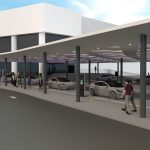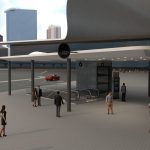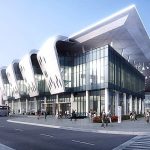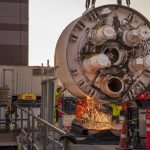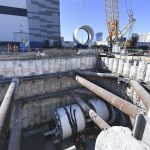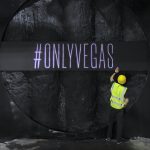
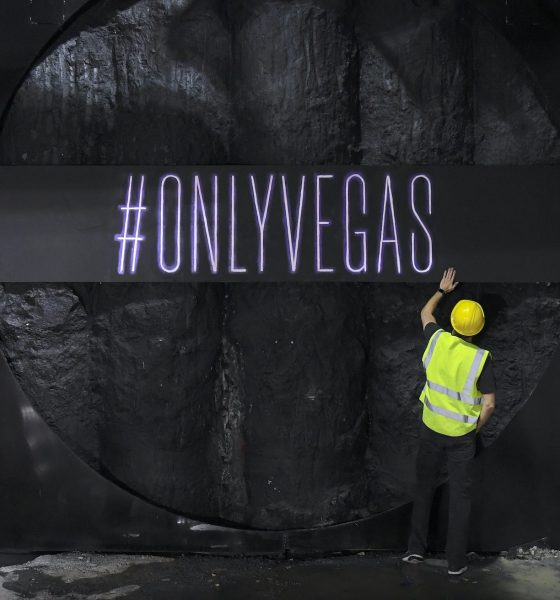
News
Elon Musk’s Boring Company completes Las Vegas tunnel major milestone
The Boring Company’s first Las Vegas tunnel reached a major milestone on Friday after completing excavation on the first of two planned vehicular tunnels beneath the Las Vegas Convention Center campus.
The boring machine broke through its target destination – a concrete wall located on the West Hall convention that’s currently under construction – in record time after tunneling nearly a mile since The Boring Company’s groundbreaking event in Las Vegas on November 15, 2019.
This would mark the first half of its high-speed transport system intended to shuttle convention attendees across the sprawling Las Vegas Convention campus in just over one minute, free of charge, in all-electric Tesla vehicles. Tesla’s goal is to complete the Las Vegas Convention Center’s loop system on time for the next year’s 2021 CES technology show.
Once the first tunnel is completed, the tunneling startup is expected to disassemble its TBM from the west end of the West Hall and moved back to the east end of the East Hall. Doing so completes the second tunnel, and it will mark the completion of the LVCC Loop’s transport line. After this, work will commence on fitting the tunnels to support The Boring Company’s transport pods, which will be ferrying passengers from one end of the LVCC to another.
- Conceptual rendering of a Boring Company People Mover station at the Las Vegas Convention Center, released November 2019. (The Boring Company)
- Conceptual rendering of a Boring Company People Mover station at the Las Vegas Convention Center, released November 2019. (The Boring Company)
The Las Vegas transport tunnels will be the first mainstream project of The Boring Company. Prior to the LVCC Loop, the tunneling startup has only completed a proof-of-concept tunnel in Hawthorne, CA, which involved Tesla Model X SUVs ferrying passengers from one end of the line to another. The Las Vegas tunnel system is poised to utilize another type of vehicle to transport passengers. The line will reportedly be using autonomous vehicles that have enough room for up to 16 people.
While The Boring Company’s transport tunnel in Las Vegas is progressing well, the project is starting to become quite polarizing. In a statement to Inverse, Richard N. Velotta, a journalist who has been following the project’s progress, noted that public opinion has become very mixed today. “What I find most interesting is that those who are opposed are extremely opposed. Those who support are extremely supportive. No middle-of-the-road here,” he said.
Among the LVCC Loop’s critics is Mayor Carolyn Goodman, who argued that the Boring Company and its technology are largely untested, and therefore risky. Yet, it should be noted that the tunneling startup’s contract for the project includes stipulations ensuring that The Boring Company will be liable if the system does not operate as intended. On the other hand, the project also has a number of ardent supporters.
“There are huge supporters, both of the Boring system and Mr. Musk. They point out that Las Vegas, as a gambling city, has always taken big risks to capitalize on big rewards. This project is just such an instance,” said Velotta.
- Workers cut the storage rack from the base of the drill head as the Boring Company prepares to lower the drill head for the People Mover tunnel which will connect convention halls as part of the LVCCD Phase 2 construction in the Red Lot east of the south Hall at the Las Vegas Convention center on Monday, Oct. 28, 2019. (Mark Damon/Las Vegas News Bureau)
- Workers from the Boring Company guide the third of three parts of the drill which will make the tunnel for the People Mover which will connect convention halls as part of the LVCCD Phase 2 construction in the Red Lot east of the south Hall at the Las Vegas Convention center Tuesday, October 29, 2019. (Sam Morris/Las Vegas News Bureau)
- Ryan Rabbass works on painting the LVCVAís new slogan ì#onlyvegasî on the wall of a pit that The Boring Company drill will emerge from Wednesday, February 12, 2020, at the Las Vegas Convention Centerís new West Hall. (Sam Morris/Las Vegas News Bureau)
(Press release from the Las Vegas Convention and Visitors Authority)
Las Vegas Convention Center Celebrates Major Milestone in Elon Musk’s Innovative Underground Transportation System; Excavation of First Tunnel Complete
LAS VEGAS – The Las Vegas Convention and Visitors Authority (LVCVA) today announced that excavation is complete in the first of two vehicular tunnels that will comprise TBC – The Boring Company d/b/a Vegas Loop underground transportation system located beneath the Las Vegas Convention Center campus. After tunneling forty feet underground for nearly a mile over the past three months, the boring machine hours ago broke through the concrete wall located near the 1.4 million square foot West Hall convention center expansion, currently under construction, signaling the official completion of excavation for the first of two one-way tunnels.
The Convention Center Loop was designed to serve as an innovative, fun and quick transportation solution to move thousands of convention attendees throughout the more than 200-acre campus with the potential for expansion in the near future to ease congestion throughout the Las Vegas resort corridor.
Next, the machine will be disassembled, transported via trucks and lowered back into the launch pit near the Convention Center’s South Hall where it will begin boring a parallel path adjacent to the first tunnel. The first commercial endeavor for the new tunneling company is designed to transport up to 4,400 convention attendees per hour and is scheduled to debut to the public in January 2021.
“This marks an important milestone in the future of transportation,” said Steve Hill, LVCVA CEO and president. “Las Vegas is proud to lead the way as the first and only destination to offer an underground transportation solution for moving visitors throughout our convention center.”
The $52.5 million underground transportation system will include three passenger stations connecting the existing 3.2 million square-foot of convention space with the convention center’s new West Hall, part of a $1.52 billion expansion and renovation. The system will allow convention attendees to be whisked across the sprawling campus in just over one minute, free of charge, in all-electric Tesla vehicles.

News
Tesla starts showing how FSD will change lives in Europe
Local officials tested the system on narrow country roads and were impressed by FSD’s smooth, human-like driving, with some calling the service a game-changer for everyday life in areas that are far from urban centers.

Tesla has launched Europe’s first public shuttle service using Full Self-Driving (Supervised) in the rural Eifelkreis Bitburg-Prüm region of Germany, demonstrating how the technology can restore independence and mobility for people who struggle with limited transport options.
Local officials tested the system on narrow country roads and were impressed by FSD’s smooth, human-like driving, with some calling the service a game-changer for everyday life in areas that are far from urban centers.
Officials see real impact on rural residents
Arzfeld Mayor Johannes Kuhl and District Administrator Andreas Kruppert personally tested the Tesla shuttle service. This allowed them to see just how well FSD navigated winding lanes and rural roads confidently. Kruppert said, “Autonomous driving sounds like science fiction to many, but we simply see here that it works totally well in rural regions too.” Kuhl, for his part, also noted that FSD “feels like a very experienced driver.”
The pilot complements the area’s “Citizen Bus” program, which provides on-demand rides for elderly residents who can no longer drive themselves. Tesla Europe shared a video of a demonstration of the service, highlighting how FSD gives people their freedom back, even in places where public transport is not as prevalent.
What the Ministry for Economic Affairs and Transport says
Rhineland-Palatinate’s Minister Daniela Schmitt supported the project, praising the collaboration that made this “first of its kind in Europe” possible. As per the ministry, the rural rollout for the service shows FSD’s potential beyond major cities, and it delivers tangible benefits like grocery runs, doctor visits, and social connections for isolated residents.
“Reliable and flexible mobility is especially vital in rural areas. With the launch of a shuttle service using self-driving vehicles (FSD supervised) by Tesla in the Eifelkreis Bitburg-Prüm, an innovative pilot project is now getting underway that complements local community bus services. It is the first project of its kind in Europe.
“The result is a real gain for rural mobility: greater accessibility, more flexibility and tangible benefits for everyday life. A strong signal for innovation, cooperation and future-oriented mobility beyond urban centers,” the ministry wrote in a LinkedIn post.
News
Tesla China quietly posts Robotaxi-related job listing
Tesla China is currently seeking a Low Voltage Electrical Engineer to work on circuit board design for the company’s autonomous vehicles.

Tesla has posted a new job listing in Shanghai explicitly tied to its Robotaxi program, fueling speculation that the company is preparing to launch its dedicated autonomous ride-hailing service in China.
As noted in the listing, Tesla China is currently seeking a Low Voltage Electrical Engineer to work on circuit board design for the company’s autonomous vehicles.
Robotaxi-specific role
The listing, which was shared on social media platform X by industry watcher @tslaming, suggested that Tesla China is looking to fill the role urgently. The job listing itself specifically mentions that the person hired for the role will be working on the Low Voltage Hardware team, which would design the circuit boards that would serve as the nervous system of the Robotaxi.
Key tasks for the role, as indicated in the job listing, include collaboration with PCB layout, firmware, mechanical, program management, and validation teams, among other responsibilities. The role is based in Shanghai.
China Robotaxi launch
China represents a massive potential market for robotaxis, with its dense urban centers and supportive policies in select cities. Tesla has limited permission to roll out FSD in the country, though despite this, its vehicles have been hailed as among the best in the market when it comes to autonomous features. So far, at least, it appears that China supports Tesla’s FSD and Robotaxi rollout.
This was hinted at in November, when Tesla brought the Cybercab to the 8th China International Import Expo (CIIE) in Shanghai, marking the first time that the autonomous two-seater was brought to the Asia-Pacific region. The vehicle, despite not having a release date in China, received a significant amount of interest among the event’s attendees.
Elon Musk
Elon Musk and Tesla AI Director share insights after empty driver seat Robotaxi rides
The executives’ unoccupied tests hint at the rapid progress of Tesla’s unsupervised Robotaxi efforts.

Tesla CEO Elon Musk and AI Director Ashok Elluswamy celebrated Christmas Eve by sharing personal experiences with Robotaxi vehicles that had no safety monitor or occupant in the driver’s seat. Musk described the system’s “perfect driving” around Austin, while Elluswamy posted video from the back seat, calling it “an amazing experience.”
The executives’ unoccupied tests hint at the rapid progress of Tesla’s unsupervised Robotaxi efforts.
Elon and Ashok’s firsthand Robotaxi insights
Prior to Musk and the Tesla AI Director’s posts, sightings of unmanned Teslas navigating public roads were widely shared on social media. One such vehicle was spotted in Austin, Texas, which Elon Musk acknowleged by stating that “Testing is underway with no occupants in the car.”
Based on his Christmas Eve post, Musk seemed to have tested an unmanned Tesla himself. “A Tesla with no safety monitor in the car and me sitting in the passenger seat took me all around Austin on Sunday with perfect driving,” Musk wrote in his post.
Elluswamy responded with a 2-minute video showing himself in the rear of an unmanned Tesla. The video featured the vehicle’s empty front seats, as well as its smooth handling through real-world traffic. He captioned his video with the words, “It’s an amazing experience!”
Towards Unsupervised operations
During an xAI Hackathon earlier this month, Elon Musk mentioned that Tesla owed be removing Safety Monitors from its Robotaxis in Austin in just three weeks. “Unsupervised is pretty much solved at this point. So there will be Tesla Robotaxis operating in Austin with no one in them. Not even anyone in the passenger seat in about three weeks,” he said. Musk echoed similar estimates at the 2025 Annual Shareholder Meeting and the Q3 2025 earnings call.
Considering the insights that were posted Musk and Elluswamy, it does appear that Tesla is working hard towards operating its Robotaxis with no safety monitors. This is quite impressive considering that the service was launched just earlier this year.
